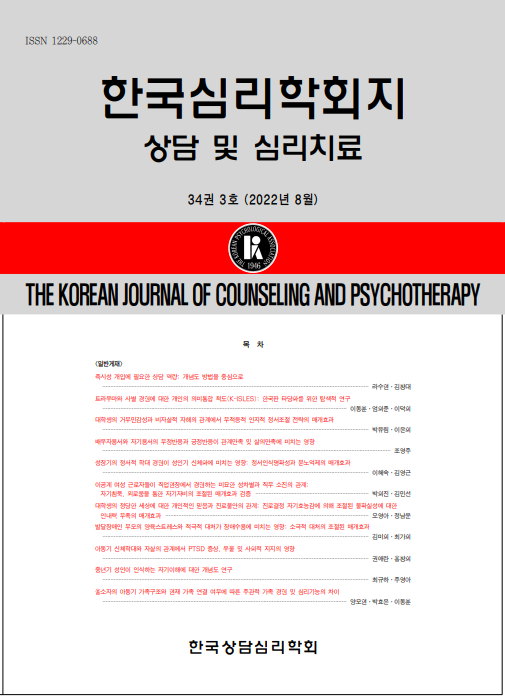open access
메뉴
open access
메뉴 ISSN : 1229-0688
ISSN : 1229-0688

The present Study was designed to compare the effects of intensive assertiveness training and non-intensive assertiveness training on assertive behavior, interpersonal relationship, self-esteem, and general sense of well-being. Intensive assertiveness training group subjects were 17 adults who felt problems in assertiveness. Non-intensive assertiveness training group subjects were 23 adults who felt problems in assertiveness. For intensive assertiveness training group, assertiveness training program was administered for 1 week, 3 times a week and each training program lasted 8 to 8.5 hours. For non-intensive assertiveness training group, assertiveness training program was administered for 10 weeks, once a week and each training program lasted 2.5 hours. Same assertiveness training program was applied to both groups. Same instruments were also administered before and after the program in both groups. The instruments used in this study were Rathus Assertiveness Scale, Relationship change Scale, Self-Esteem Inventory, and Index of Well-Being. The Pretest-Posttest design was used for both groups to measure the effectiveness of the intensive and non-intensive assertiveness training program. For statistical comparison of the effectiveness of intensive assertiveness training and that of non-intensive assertiveness training, MANOVA was used. The results were as follows: First, statistically significant increase of assertive behavior was found in both groups after the application of assertiveness training program. The results showed that assertive behaviors of subjects in non-intensive assertiveness training group were improved more than those in intensive assertiveness training group. The training effect of non-intensive assertiveness training was statistically better than that of intensive assertiveness training for increasing assertive behavior. Second, statistically significant improvement in overall interpersonal relationship was found in both groups after the application of assertiveness training program. There was no statistically significant training effect difference between intensive assertiveness training and non-intensive assertiveness training. Although the scores of 7 subareas of relationship change scale were increased in both groups, the subarea of sensitivity was not statistically improved in both groups. Besides, the subarea of openness in intensive assertiveness training group was not statistically improved. Third, although the scores of self-esteem in both groups were increased, only in non-intensive assertiveness training group self-esteem improved statistically. The training effect of non-intensive assertiveness training was statistically better than that of intensive assertiveness training for enhancing self-esteem. Lastly, the scores of General Affect and Overall Life Satisfaction, which were two subareas of general sense of Well-Being, were improved statistically in both groups after the application of assertiveness training. There was no statistical training effect difference between intensive assertiveness training and non-intensive assertiveness training for enhancing overall life satisfaction. However, there was training effect difference for improving general affect. Statistically non-intensive assertiveness training was more effective than that of intensive assertiveness training for improving general affect. As summarized above, intensive assertiveness training statistically improved scores of all the measures except self-esteem and two subareas of relationship change scales such as sensitivity and openness. Non-intensive assertiveness training, however, statistically improved scores of all the measures except sensitivity, the subarea of relationship change scale. Besides, the results showed that non-intensive assertiveness training was statistically more effective than intensive assertiveness training for improving assertive behavior, self-esteem, and general affect.
